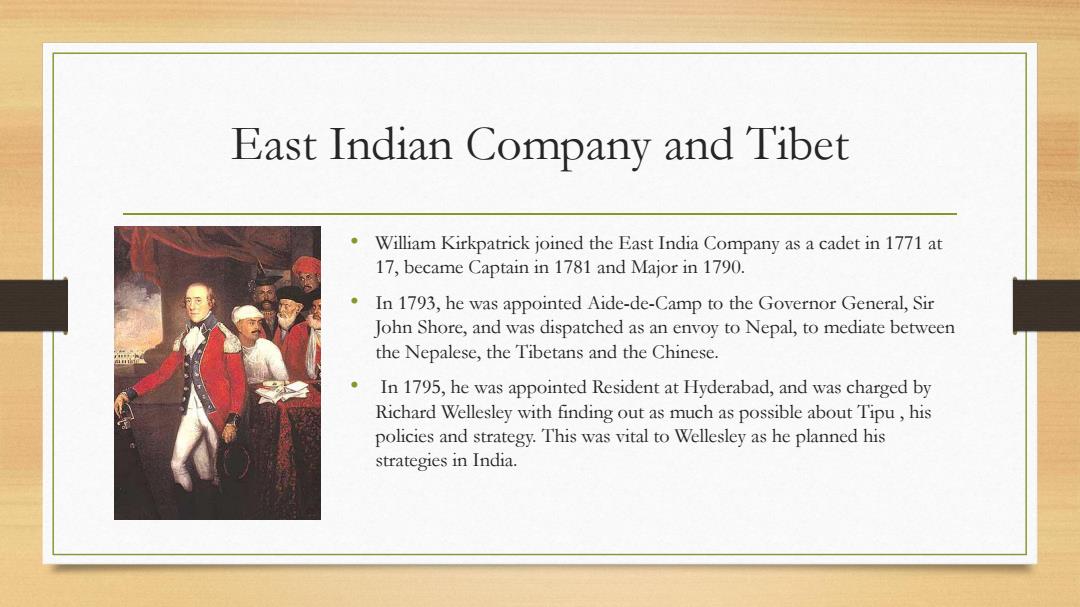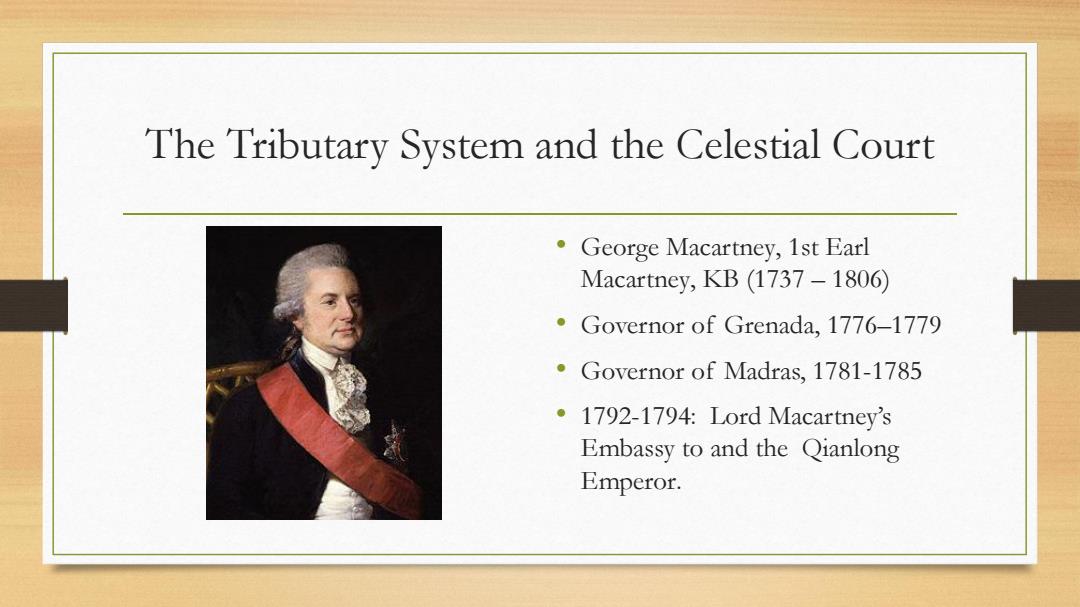
East Indian Company and Tibet William Kirkpatrick joined the East India Company as a cadet in 1771 at 17,became Captain in 1781 and Major in 1790. .In 1793,he was appointed Aide-de-Camp to the Governor General,Sir John Shore,and was dispatched as an envoy to Nepal,to mediate between the Nepalese,the Tibetans and the Chinese. In 1795,he was appointed Resident at Hyderabad,and was charged by Richard Wellesley with finding out as much as possible about Tipu,his policies and strategy.This was vital to Wellesley as he planned his strategies in India
East Indian Company and Tibet • William Kirkpatrick joined the East India Company as a cadet in 1771 at 17, became Captain in 1781 and Major in 1790. • In 1793, he was appointed Aide-de-Camp to the Governor General, Sir John Shore, and was dispatched as an envoy to Nepal, to mediate between the Nepalese, the Tibetans and the Chinese. • In 1795, he was appointed Resident at Hyderabad, and was charged by Richard Wellesley with finding out as much as possible about Tipu , his policies and strategy. This was vital to Wellesley as he planned his strategies in India

The Tributary System and the Celestial Court George Macartney,1st Earl Macartney,KB(1737-1806) Governor of Grenada,1776-1779 Governor of Madras,1781-1785 .1792-1794:Lord Macartney's Embassy to and the Qianlong Emperor
The Tributary System and the Celestial Court • George Macartney, 1st Earl Macartney, KB (1737 – 1806) • Governor of Grenada, 1776–1779 • Governor of Madras, 1781-1785 • 1792-1794: Lord Macartney ’s Embassy to and the Qianlong Emperor

The Governor of Madras(钦奈/请奈) Macarmey was the Governor of Madras from 1781 to 1785.During his tenure as govemor,renovation and strengthening of the walls of Fort St.George was commenced after the siege of lally and completed in 1783.It was also during this time that most of the buildings and barracks in the western portion of the Fort were erected.The Palace Street,the Arsenal,the Hanover square and the Western Barracks were constructed during this time.The streets in the eastern side of the Fort were also altered. It was also during this time that idea of a police force for Madras was thought of. Popham,the brainchild of the street which would bear his name (Popham's Broadway) submitted a plan for the establishment of a regular police force for Madras and for the building of direct and cross drains in every street.He also advocated measures for the naming and lighting of streets,for the regular registration of births and deaths and for the licensing of lquor,arrack and toddy shops.A Board of Police assisted by a Kotwal was subsequently formed.The Kotwal was to be the officer of the markets under the Superintendent of Police. He negotiated the Treary of Mangalore which brought an end to the Second Anglo- Mysore War in 1784. Macartney declined the govemnor-generalship of India (then the British terrirories administered by the Britsh East India Company)and returned to Britain in 1786
The Governor of Madras (钦奈/清奈) • Macartney was the Governor of Madras from 1781 to 1785. During his tenure as governor, renovation and strengthening of the walls of Fort St. George was commenced after the siege of Lally and completed in 1783. It was also during this time that most of the buildings and barracks in the western portion of the Fort were erected. The Palace Street, the Arsenal, the Hanover square and the Western Barracks were constructed during this time. The streets in the eastern side of the Fort were also altered. • It was also during this time that idea of a police force for Madras was thought of. Popham, the brainchild of the street which would bear his name (Popham's Broadway) submitted a plan for the establishment of a regular police force for Madras and for the building of direct and cross drains in every street. He also advocated measures for the naming and lighting of streets, for the regular registration of births and deaths and for the licensing of liquor, arrack and toddy shops. A Board of Police assisted by a Kotwal was subsequently formed. The Kotwal was to be the officer of the markets under the Superintendent of Police.[ • He negotiated the Treaty of Mangalore which brought an end to the Second Anglo- Mysore War in 1784. • Macartney declined the governor-generalship of India (then the British territories administered by the British East India Company) and returned to Britain in 1786

The Macartney Embassy to China The delegation departed Portsmouth aboard three ships on 26 September 1792.The warship HM.S Liom,commanded by Captain Sir Erasmus Gower,led the mission.The Hindostam,belonging to the East India Company was commanded by Captain William Mackintosh.These two vessels were accompanied by a brig,the Jackall A storm soon hit the squadron, forcing it to stop temporarily at Tor Bay.After making repairs,the Liom and Hindortan resumed their voyage without the Jackall,which had gone missing in the storm.Fortunately,the gifts to be presented to the emperor were stored on the Liom and the Hindostan.Thomas Staunton spent the voyage studying Chinese with the mission's interpreters The squadron stopped at Madeira(马得)in early October..On 1 November,,they arrived at Cape Verde(维得角).The trade winds off the coast of Africa forced them to sail west all the way to Rio de Janeiro(里约热内,where they arrived at the end of November. The expedition departed Rio de Janeiro on 17 December and sailed east once more,rounding the Cape of Good Hope on 7 January 1793.They passed Java in February,and reached Jakarta on 6 March.There,they bought a French brig which they christened the Clarence,to replace the Jackall.The Jackall itself,however,rejoined the squadron at Jakarta,after having turned back for repairs after the storm that had struck the ships at the start of their voyage.The full squadron sailed on to Macau,where they arrived on 19 June 1793.For the next leg of the trip,Macartney and Dundas had intended to avoid Guangzhou altogether.Instead of proceeding overland from there,the plan was for the embassy to continue by sea to Tianjin,the closest major port to Beijing
The Macartney Embassy to China • The delegation departed Portsmouth aboard three ships on 26 September 1792. The warship HMS Lion, commanded by Captain Sir Erasmus Gower, led the mission.The Hindostan, belonging to the East India Company was commanded by Captain William Mackintosh. These two vessels were accompanied by a brig, the Jackall. A storm soon hit the squadron, forcing it to stop temporarily at Tor Bay. After making repairs, the Lion and Hindostan resumed their voyage without the Jackall, which had gone missing in the storm. Fortunately, the gifts to be presented to the emperor were stored on the Lion and the Hindostan. Thomas Staunton spent the voyage studying Chinese with the mission’s interpreters. • The squadron stopped at Madeira (马得拉) in early October. On 1 November, they arrived at Cape Verde (维得角). The trade winds off the coast of Africa forced them to sail west all the way to Rio de Janeiro (里约热内庐), where they arrived at the end of November. • The expedition departed Rio de Janeiro on 17 December and sailed east once more, rounding the Cape of Good Hope on 7 January 1793. They passed Java in February, and reached Jakarta on 6 March. There, they bought a French brig which they christened the Clarence, to replace the Jackall. The Jackall itself, however, rejoined the squadron at Jakarta, after having turned back for repairs after the storm that had struck the ships at the start of their voyage. The full squadron sailed on to Macau, where they arrived on 19 June 1793. For the next leg of the trip, Macartney and Dundas had intended to avoid Guangzhou altogether. Instead of proceeding overland from there, the plan was for the embassy to continue by sea to Tianjin, the closest major port to Beijing